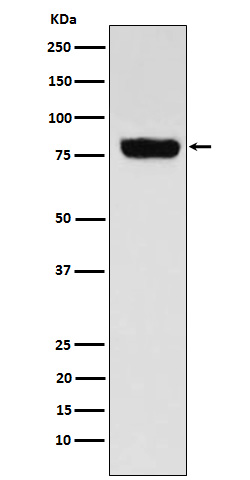SLC22A3 Antibody
Rabbit mAb
- 产品详情
- 实验流程
Application
| WB, IHC, FC |
|---|---|
| Primary Accession | O75751 |
| Reactivity | Human |
| Clonality | Monoclonal |
| Other Names | EMT; EMTH; OCT3; Orct3; Slc22a3; |
| Isotype | Rabbit IgG |
| Host | Rabbit |
| Calculated MW | 61280 Da |
| Dilution | WB 1:500~1:2000 IHC 1:50~1:200 FC 1:50 |
|---|---|
| Purification | Affinity-chromatography |
| Immunogen | A synthesized peptide derived from human SLC22A3 |
| Description | Mediates potential-dependent transport of a variety of organic cations. May play a significant role in the disposition of cationic neurotoxins and neurotransmitters in the brain. |
| Storage Condition and Buffer | Rabbit IgG in phosphate buffered saline , pH 7.4, 150mM NaCl, 0.02% sodium azide and 50% glycerol. Store at +4°C short term. Store at -20°C long term. Avoid freeze / thaw cycle. |
| Name | SLC22A3 (HGNC:10967) |
|---|---|
| Function | Electrogenic voltage-dependent transporter that mediates the transport of a variety of organic cations such as endogenous bioactive amines, cationic drugs and xenobiotics (PubMed:10196521, PubMed:10966924, PubMed:12538837, PubMed:17460754, PubMed:20858707). Cation cellular uptake or release is driven by the electrochemical potential, i.e. membrane potential and concentration gradient (PubMed:10966924). Functions as a Na(+)- and Cl(-)-independent, bidirectional uniporter (PubMed:12538837). Implicated in monoamine neurotransmitters uptake such as dopamine, adrenaline/epinephrine, noradrenaline/norepinephrine, histamine, serotonin and tyramine, thereby supporting a role in homeostatic regulation of aminergic neurotransmission in the brain (PubMed:10196521, PubMed:16581093, PubMed:20858707). Transports dopaminergic neuromodulators cyclo(his- pro) and salsolinol with low efficiency (PubMed:17460754). May be involved in the uptake and disposition of cationic compounds by renal clearance from the blood flow (PubMed:10966924). May contribute to regulate the transport of cationic compounds in testis across the blood-testis-barrier (Probable). Mediates the transport of polyamine spermidine and putrescine (By similarity). Mediates the bidirectional transport of polyamine agmatine (PubMed:12538837). Also transports guanidine (PubMed:10966924). May also mediate intracellular transport of organic cations, thereby playing a role in amine metabolism and intracellular signaling (By similarity). |
| Cellular Location | Cell membrane; Multi-pass membrane protein. Apical cell membrane; Multi-pass membrane protein. Basolateral cell membrane; Multi-pass membrane protein. Mitochondrion membrane {ECO:0000250|UniProtKB:O88446}. Endomembrane system {ECO:0000250|UniProtKB:O88446}. Nucleus membrane {ECO:0000250|UniProtKB:O88446}. Nucleus outer membrane {ECO:0000250|UniProtKB:O88446}. Note=Localized to the apical/brush border membrane of enterocytes (PubMed:16263091). Localized to the luminal/apical membrane of ciliated epithelial cells in bronchi (PubMed:15817714). Localized to the basolateral membrane of intermediate cells in bronchi (PubMed:15817714). Localized to the entire plasma membrane of basal cells in bronchi (PubMed:15817714) |
| Tissue Location | Expressed in liver (PubMed:10196521, PubMed:9933568). Expressed in intestine (PubMed:16263091, PubMed:20858707). Expressed in kidney in proximal tubular cells (PubMed:10966924). Expressed in placenta (PubMed:10966924, PubMed:9933568). Expressed throughout the brain, including cerebral cortex, cerebrellum, substancia nigra, medulla oblongata, hippocampus, caudate nucleus, nucleus accumbens and pons with low levels of expression detected in nearly all brain regions (PubMed:10196521, PubMed:20858707). In testis, mostly localized to peritubular myoid cells and Leydig cells, and weakly expressed in developing germ cells (PubMed:35307651). Expressed in tracheal and bronchial epithelium of the respiratory tract, where it localizes to the apical membrane of ciliated cells, the entire membrane of basal cells and the basolateral membrane of intermediate cells (PubMed:15817714). Expressed in skeletal muscle, adrenal gland, heart, prostate, aorta, salivary gland, adrenal gland, uterus, lymph node, lung, trachea and spinal cord (PubMed:10196521, PubMed:20858707, PubMed:9933568). Expressed in fetal lung and liver (PubMed:9933568). |
Research Areas
For Research Use Only. Not For Use In Diagnostic Procedures.
Application Protocols
Provided below are standard protocols that you may find useful for product applications.
终于等到您。ABCEPTA(百远生物)抗体产品。
点击下方“我要评价 ”按钮提交您的反馈信息,您的反馈和评价是我们最宝贵的财富之一,
我们将在1-3个工作日内处理您的反馈信息。
如有疑问,联系:0512-88856768 tech-china@abcepta.com.
¥ 1,500.00
Cat# AP92523























 癌症的基本特征包括细胞增殖、血管生成、迁移、凋亡逃避机制和细胞永生等。找到癌症发生过程中这些通路的关键标记物和对应的抗体用于检测至关重要。
癌症的基本特征包括细胞增殖、血管生成、迁移、凋亡逃避机制和细胞永生等。找到癌症发生过程中这些通路的关键标记物和对应的抗体用于检测至关重要。 为您推荐一个泛素化位点预测神器——泛素化分析工具,可以为您的蛋白的泛素化位点作出预测和评分。
为您推荐一个泛素化位点预测神器——泛素化分析工具,可以为您的蛋白的泛素化位点作出预测和评分。 细胞自噬受体图形绘图工具为你的蛋白的细胞受体结合位点作出预测和评分,识别结合到自噬通路中的蛋白是非常重要的,便于让我们理解自噬在正常生理、病理过程中的作用,如发育、细胞分化、神经退化性疾病、压力条件下、感染和癌症。
细胞自噬受体图形绘图工具为你的蛋白的细胞受体结合位点作出预测和评分,识别结合到自噬通路中的蛋白是非常重要的,便于让我们理解自噬在正常生理、病理过程中的作用,如发育、细胞分化、神经退化性疾病、压力条件下、感染和癌症。






